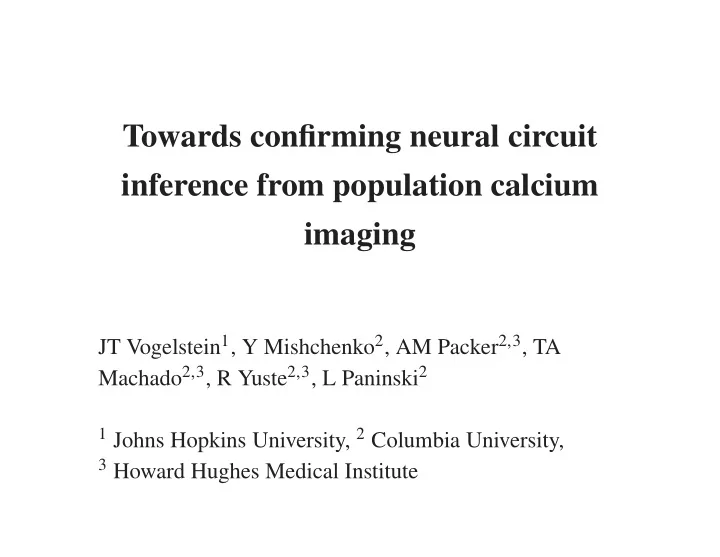

Towards confirming neural circuit inference from population calcium imaging JT Vogelstein 1 , Y Mishchenko 2 , AM Packer 2 , 3 , TA Machado 2 , 3 , R Yuste 2 , 3 , L Paninski 2 1 Johns Hopkins University, 2 Columbia University, 3 Howard Hughes Medical Institute
schematic
aim given only a set of fluorescence traces collected simultaneously from a small (eg ≈ 100 neurons) population of neurons, obtain the spike trains for each of the neurons, and the effective connectivity matrix for the observed population.
steps 1. image a population of neurons using calcium 2. segment image into regions-of-interest (ROI) 3. extract fluorescence traces from each ROI 4. infer spike trains from neural populations using a fast non-negative deconvolution algorithm [1], and refine inference using sequential monte carlo methods [2] 5. infer effective connectivity matrix given the spike trains using a specialized blockwise Metropolis-within-Gibbs sampler [3] 6. confirm sign of neurons comparing with genetically labeled inhibitory neurons [4]
generative model C i ( t ) + β i + σ F F i ( t ) = α i i ε t C i ( t ) + k d dC i ( t ) τ c = − C i ( t ) + C b i + A i n i ( t ) + σ c i ε t i dt � n i ( t ) ∼ Binomial[ f ( b i + k i s ( t ) + w i j h i j ( t )) ] i τ h dh j ( t ) = − h j ( t ) + n j ( t ) + σ h ε t dt θ = { θ i } i ≤ N , θ i = { α i , β i , σ F i , τ c i , C b i , A i , σ c i , τ h i , σ h i } X = { X i } i ≤ N , X i = { X i ( t ) } t ≤ T , X i ( t ) = { C i ( t ), n i ( t ), h i ( t ) }
fast filter P [ n i | F i ; θ i ] = argmax P [ F i | n i ; θ i ] P [ n i | θ i ] � n i = argmax n i ( t ) ≥ 0 ∀ t n i ( t ) ≥ 0 ∀ t we use an interior point method to impose the non-negativity constraint. since this is concave, we can use gradient ascent to find the optimal solution. we take advantage of the tridiagonal Hessian and use gaussian elimination to evaluate each newton step. parameters are estimated from the data using a pseudo expectation maximization algorithm.
smc filter n i ( t ) = argmax P [ n i ( t ) | F ; θ ] � n i ( t ) ∈{ 0 , 1 } � P [ X i , F i ] = P [ X i ( 0 ) ] P [ X i ( t ) | X i ( t − 1 ) ] P [ F i ( t ) | X i ( t ) ] t because we have a hidden markov model we use a forward-backward algorithm to infer the desired posterior probabilities. because we don’t know how to solve the integrals, we approximate them using sequential monte carlo (aka, smc or particle filter). parameters are estimated (from the data) using a expectation maximization algorithm.
effective connectivity inference � P [ X | F ; θ ] ≈ P [ X i | F i ; θ i ] � w = argmax w ∈{ 0 , 1 } i to obtain P [ X | F ; θ ], we develop a specialized blockwise Metropolis-within-Gibbs sampler. for more efficient (but slightly less accurate) sampling, we approximate the joint posterior as the product of marginals. to estimate the connectivity, we impose a sparse constraint, via standard L 1 penalization methods.
in vitro spike inference
in silico connectivity inference
in silico connectivity inference
in silico connectivity inference
next steps • applying the connectivity inference to real data • while already computational time is only a few minutes per cell per node on a cluster, we’d like to be able to run this online • incorporating external stimulus and unobserved neurons
bibliography [1] JT Vogelstein, B Babadi, AM Packer, T Machado, R Yuste, L Paninski. In preparation. Fast spike train inference from calcium imaging. http://jovo.github.com/fast-oopsi/ [2] JT Vogelstein, BO Watson, AM Packer, R Yuste, L Paninski. 2009. Spike inference from calcium imaging using sequential monte carlo methods. Biophysical Journal, 97: 636-655. http://jovo.github.com/smc-oopsi/ [3] Y Mishchenko, JT Vogelstein, L Paninski. In press. A Bayesian approach for inferring neuronal connectivity from calcium fluorescent imaging data. Annals of Applied Statistics. http://jovo.github.com/pop-oopsi/ [4] AA Oliva Jr, M Jiang, T Lam, KL Smith, JW Swann. 200. Novel hippocampal interneuronal subtypes indentified using transgenic mice that express green fluorescent protein in GABAergic interneurons, J Neurosci, 20:3354:3368.
acknowledgements The authors thank V. Bonin for helpful discussions and providing some of the data. Support for JTV was provided by NIDCD DC00109. LP is supported by an NSF CAREER award and by an Alfred P. Sloan Research Fellowship and the McKnight Scholar Award. RY’s laboratory was supported by grant EY11787 from the NEI and by the Kavli Institute for Brain Science at Columbia University. LP and RY are jointly supported by NSF IIS-0904353.
Recommend
More recommend